Biochar in European Viticulture: Results of the Season 2011
by Claudio Niggli & Hans-Peter Schmidt
find the print version of this article here
Experiments in Delinat vineyards
Improving soil fertility with organic substrates is a cornerstone in climate farming. Adding organic substrates to soils close material cycles and sequester carbon (C) in the soil by increasing the soil C pool. It also plays a central role in the Delinat guidelines for organic wine-growing. In order to attain the goal of climate-positive wine-growing with a high degree of biodiversity by 2015, all certified Delinat wine-makers are obliged to carry out scientific experiments in their vineyards. In connection with this program, biochar experiments were executed at more than ten Delinat properties in 2011, each having an area of at least one hectare. In four vineyards, the experimental treatments were replicated at least three times to enable statistical testing while the others were not replicated due to limited resources.
In those vineyards with at least three replicate treatment plots, first data were recorded during the growing season 2011. For reference, an experiment with four different treatments, each five fold replicated, was undertaken at the Delinat Institute in Valais, Switzerland. In all experiments, the same biochar from the German company Carbon Terra was used. It was produced from mixed wood with 80% coniferous and 20% hard wood chips, pyrolysed at temperatures of about 450°C for 36 hours (see Report Analysis of Charcoal, in German).
The following report examines the available data and draws preliminary conclusions.
Experimental set-ups in France, Spain and Italy
In order to organically charge the biochar, it was mixed with manure in a 1:1 weight ratio and kept moist for a period of two weeks (see Ways of Making Terra Preta: Biochar Activation). In spring 2011, the biochar-manure substrate was applied over the entire surface of the experimental plot, leaving three random patches of at least 100 m2 which served as controls (Fig. 1). The applied amount of 20 t/ha substrate is equivalent to a biochar amount of 10 t/ha. In the control patches, 10t/ha pure manure was applied so that each treatment received the same amount of manure. The substrates were then incorporated with a grabber into the upper-soil.
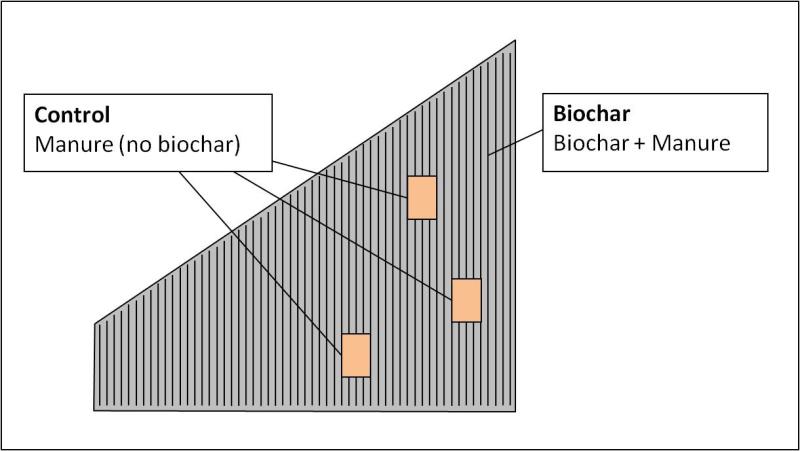
Biochar in Sicily: results
At Maggio Vini (Sicily), the supply of all nutrients in the experimental vines can basically be characterized as being suboptimal. The heterogeneity of the plots is obviously high. The leaf analyses show that for all macro elements, the treatment plots with biochar gave higher element concentrations than the control without biochar (Fig. 2). The largest differences were found in the nitrogen and potassium concentrations. Considering calcium, magnesium and phosphorus, however, the differences in relation to the large variability within a treatment group were low.
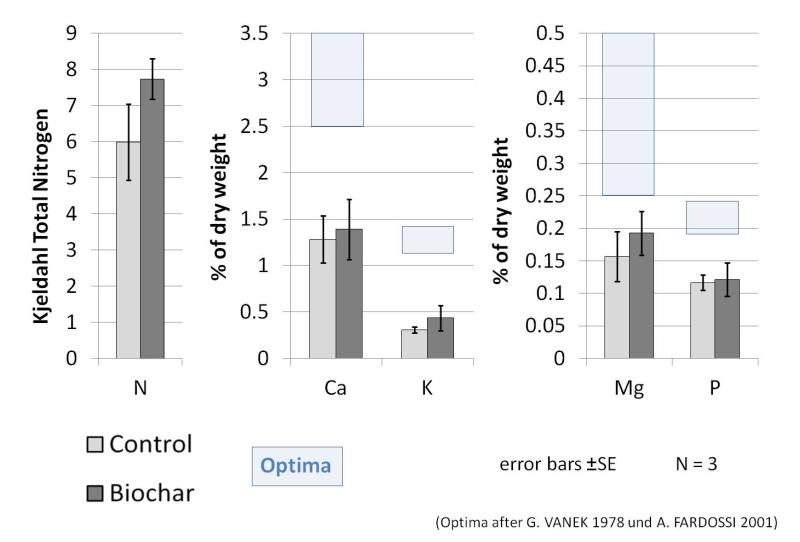
In the Italian experiment, grape analyses were already carried out in the first year. While there were no significant differences in the acid and sugar contents among the treatment groups a significant increase of 38% yeast assimilable nitrogen was found in the biochar-grown grapes (Fig. 3).
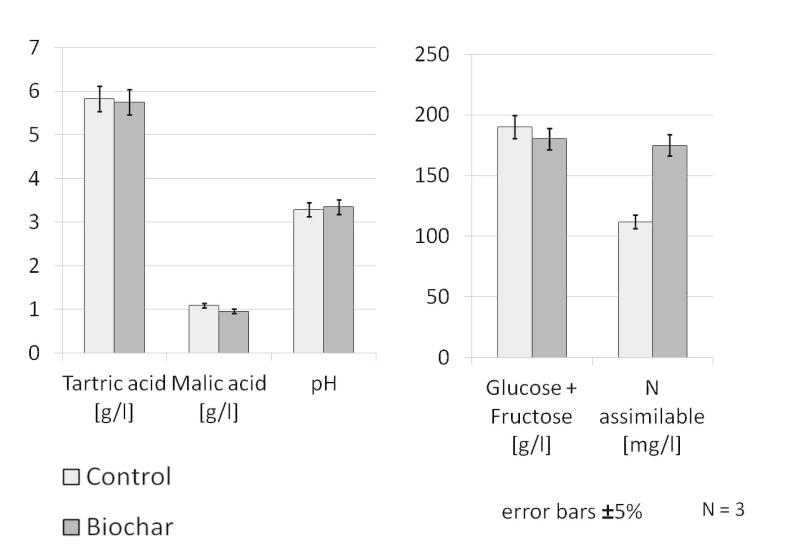
Biochar in Spain: results
The leaf analyses in the experimental vineyards at Pago Casa Gran (Valencia) show significantly higher values for treatment plots with biochar compared to control plots for all investigated elements (Fig. 4). The differences in nitrogen and manganese were most of all remarkable. As the soil pH was at 8.1, an improved water supply in the biochar treatment plots presumably explains these major differences.
Due to miscommunication, however, there are only two replicates for this data set so the results cannot be statistically evaluated.
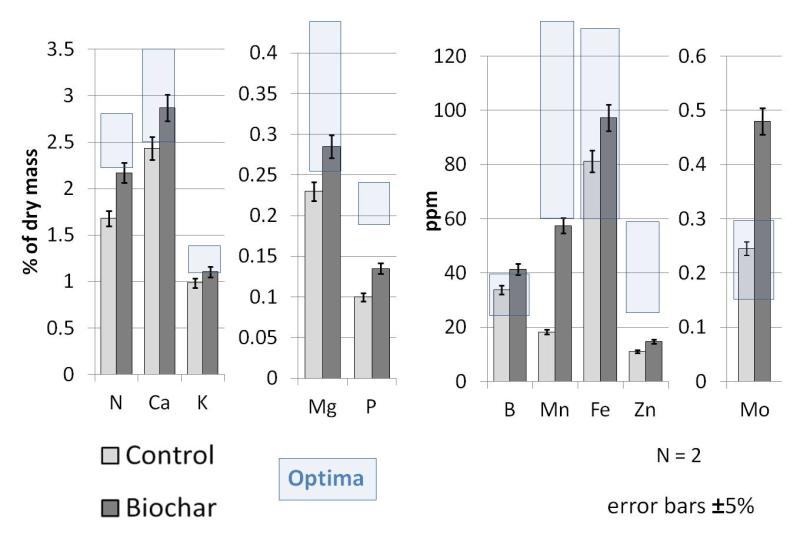
Biochar in southern France: results
The field trial at Chateau Duvivier was carried out on a one-hectare plot and in collaboration with the Chambre d'Agriculture de Var for scientific support. Six leaf samples (three from control plots with pure manure, three from biochar-manure plots) were analyzed for their macronutrient contents after half a year of biochar treatment (Fig. 5). For all five main nutrients, there was a lower nutrient content in the biochar treatment plots, but differences were significant only for calcium. For all other nutrient elements, the differences were small compared to variations within the treatment plots. Here, the heterogeneity in the experimental plots was relatively large.
While strong rains were recorded in Valencia and Sicily right after the application of the biochar substrates, the dry season in Provence began rather prior to the deployment of the substrates. Thus the biochar could not be saturated with water, rendering its high water retention capacity useless at this time. Another reason for the lower effectiveness of the biochar substrates on Château Duvivier vineyards could be that Duvivier wine-growers have been working there with vegetation systems and manure for ten years already, resulting in higher humus contents and biological activity than those of the other two vineyards in Italy and Spain. This may also have already increased the soils' water holding capacity and nutrient dynamics to relatively high values as can be seen in the absolute nutrient concentrations in the leaves which were close to the optimum as compared to the other two locations (Figs. 5, 4, 2).
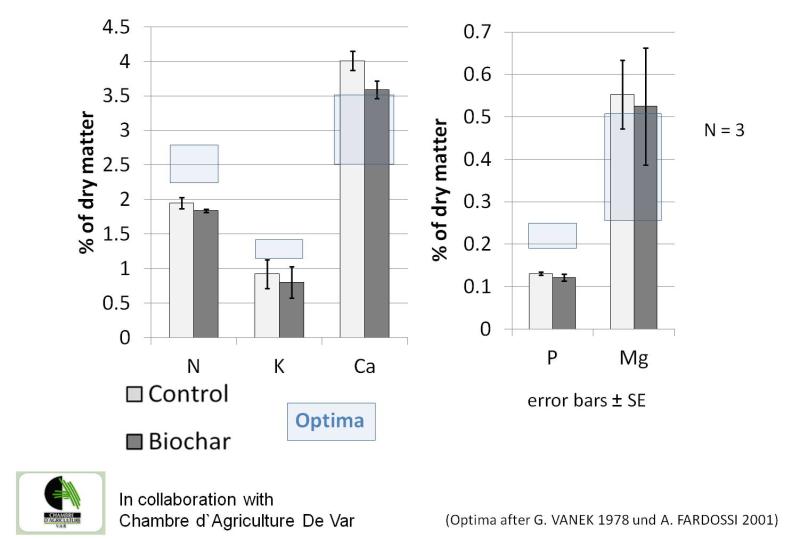
On-site experiments of Delinat Institute in Valais
At the end of spring of 2011, a new field test with three different biochar substrates was carried out in collaboration with the University of Giessen. The production of these biochar substrates was previously subject of an extensive and fully replicated composting experiment at the Delinat Institute's compost plant in St. Léonard, where the influence of biochar on the composting process and the greenhouse gas production was investigated. The effect of substrates on the germination and growth of various plants was examined in various pot experiments, garden field trials and in vineyards (results will be published in 4/2012 - see also SF1 TV Report on biochar experiments, in German).
Experimental set-up
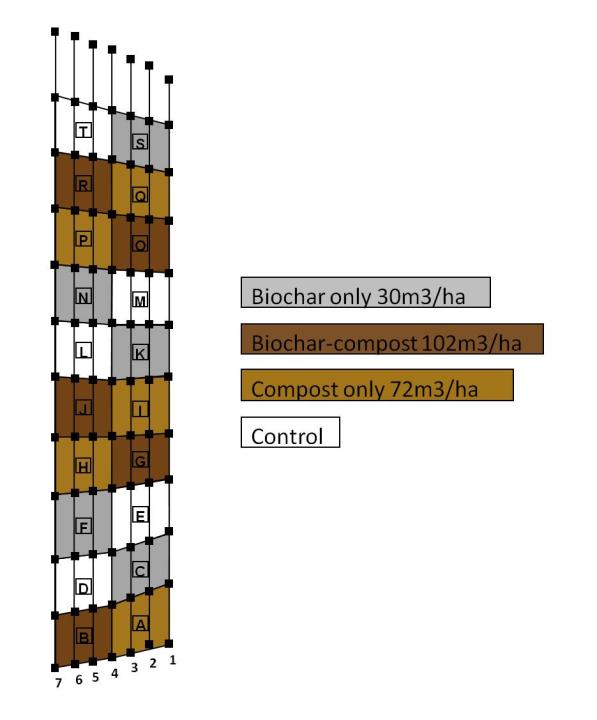
Four treatment plots with five replicates were set up in the vineyard trial in early June 2011:
V1 control: no addition of any substrate
V2 pure, fresh, non-aged and non-activated* biochar (30 m3/ha)
V3 compost (72 m3/ha)
V4 biochar-compost (102 m3/ha biochar-compost with a biochar content of 30 m3 integrated right in the beginning of the composting process)
* the term “activated” is used to mean “charged with organo-mineral nutrients and inoculated with living soil fauna.”All grape samples were of the grape variety, Pinot Noir, which was planted at this site in 1975. The samples for the analysis of leaves and grapes were analyzed as composite samples: Twelf vines were taken from the two inner rows for each treatment plot and replicate. Therefore a total of 60 vines were taken per composite sample. A composite sample consisted of 60 leaves for all leaf analyses and 300 berries for grape analyses. For micro-vinification the berries were pressed and not homogenized.
Biochar experiments - Valais 3 (field experiment: Georgette): 2011 results
Three months after substrate application, the analyses did not show significant differences in macronutrients among the treatments biochar -compost or pure compost. In the treatment with pure, non-activated biochar, however, all macronutrients, with the exception of nitrogen, showed significantly lower values.
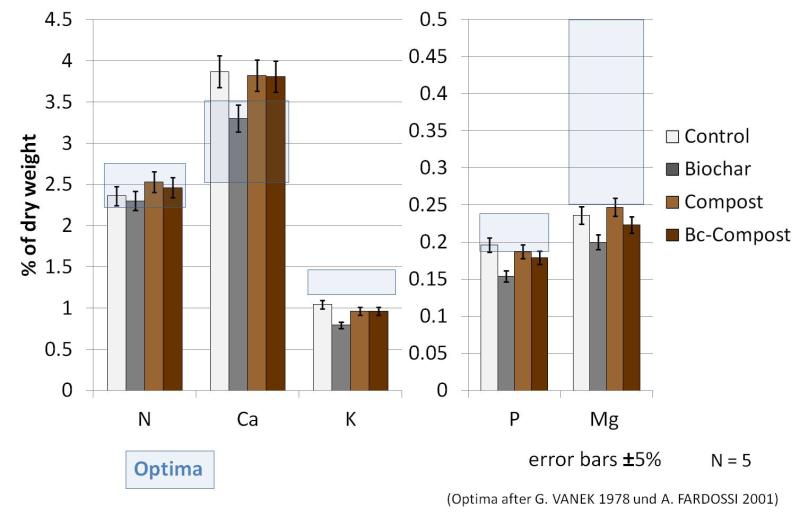
Regarding the microelements, the treatment with pure biochar again exhibited without exception the lowest values wherein, the differences in zinc and boron compared to control showed the highest deviation from the control. In comparing pure compost with the biochar-compost treatment, a tendency towards adsorption of iron and zinc in biochar becomes apparent.
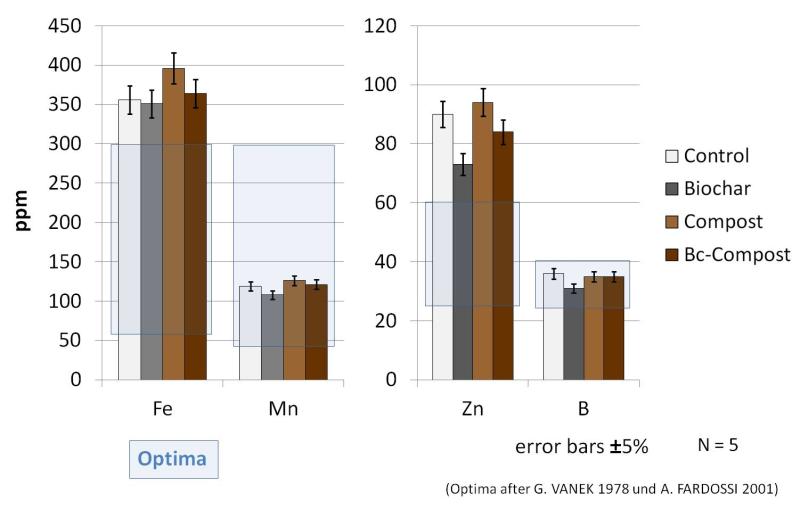
Growth potential
Analysis of the shoot diameters of one-year-old grape stems revealed that five months after substrate application, the biochar-compost resulted in significantly larger dimaeters compared to the control and it tended to produce shoots with larger stem diameters than the treatments with pure biochar and pure compost.
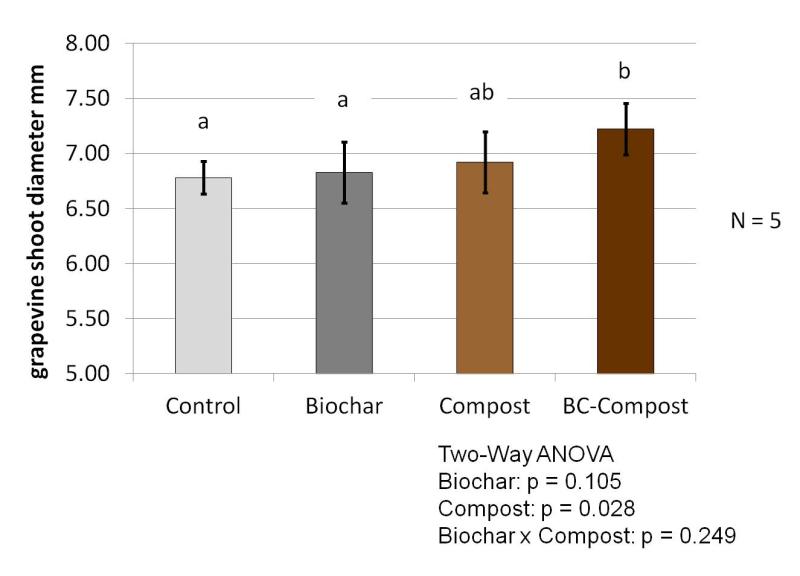
Grape Components
The grapes were analyzed at the time of harvest, i.e., 105 days after the substrates were applied. The pH values of grapes in the treatment groups differed only slightly from each other (Fig. 10) with the lowest pH measured in the control. The highest total acid value was obtained in the control and the lowest value in the compost treatment plot. The anthocyanin content was higher in the treatment plots with biochar and biochar-compost than in the control or pure compost treatments. The polyphenol content was highest in the treatment plot with pure compost.
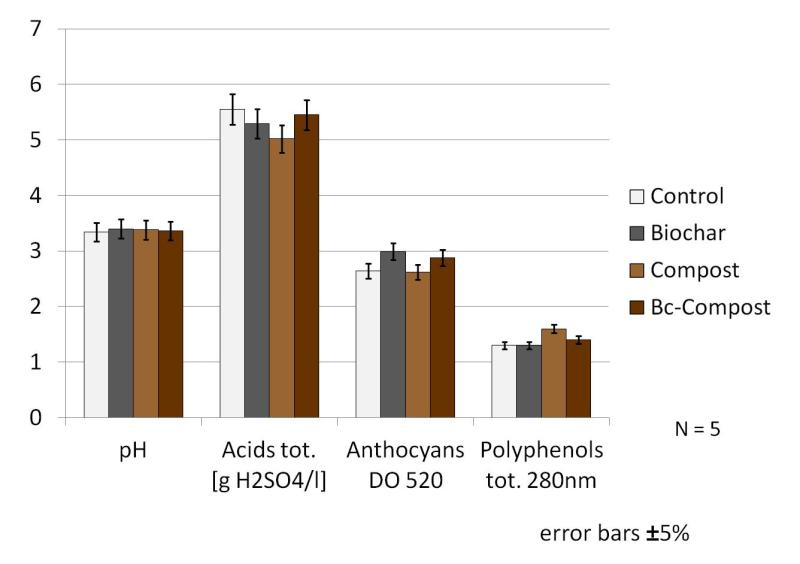
The sugar content was higher by 5.5% in the pure biochar treatment than in the control, and lower by 3% in the compost treatment. The yeast assimilable amino nitrogen was in the treatments compost and biochar-compost higher than in the control, by 19% and 22.5%, respectively. The results thus correspond well with the results from Sicily which exhibit the same trend. The concentration of yeast assimilable nitrogen in the grapes from the treatment with pure, non-activated biochar was markedly lower.
The pooled sampling of grape berries does not allow for a statistical analysis. However, the sampling pattern throughout the five replicates with a total of 300 berries from 300 grapes and 60 vine trees per sample is assumed to result in representative values.
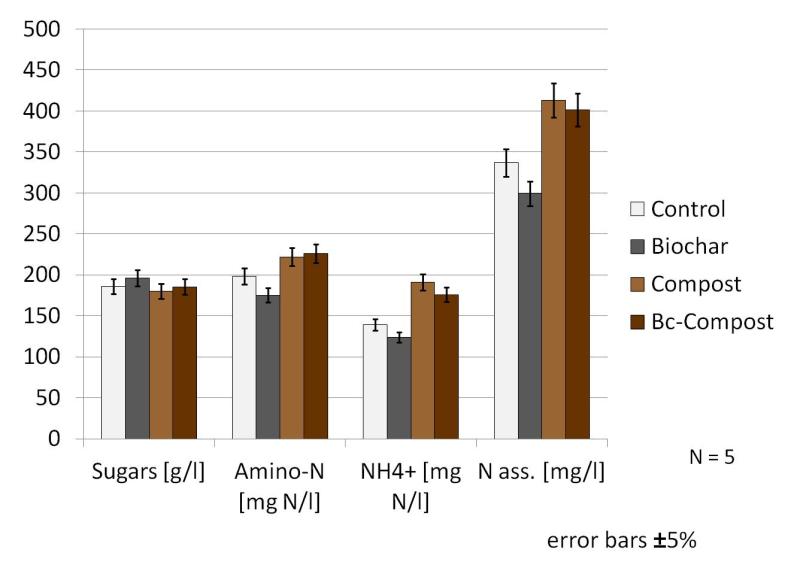
Must analysis
Must analysis revealed a significant increase in pH in treatments with compost and biochar (Fig. 12). There was no significant interaction of biochar and compost. With respect to the Pinot Noir, which was investigated in this experimental field, a slight decrease in acidity is quite welcome; it confirms the results from experiments of previous years. In the southern wine-growing regions a considerable decrease of the acid content, however, could rather mean a loss in quality. Thus, special attention must be given to the acidity of the grapes in the coming campaign, especially in the southern European vineyards.
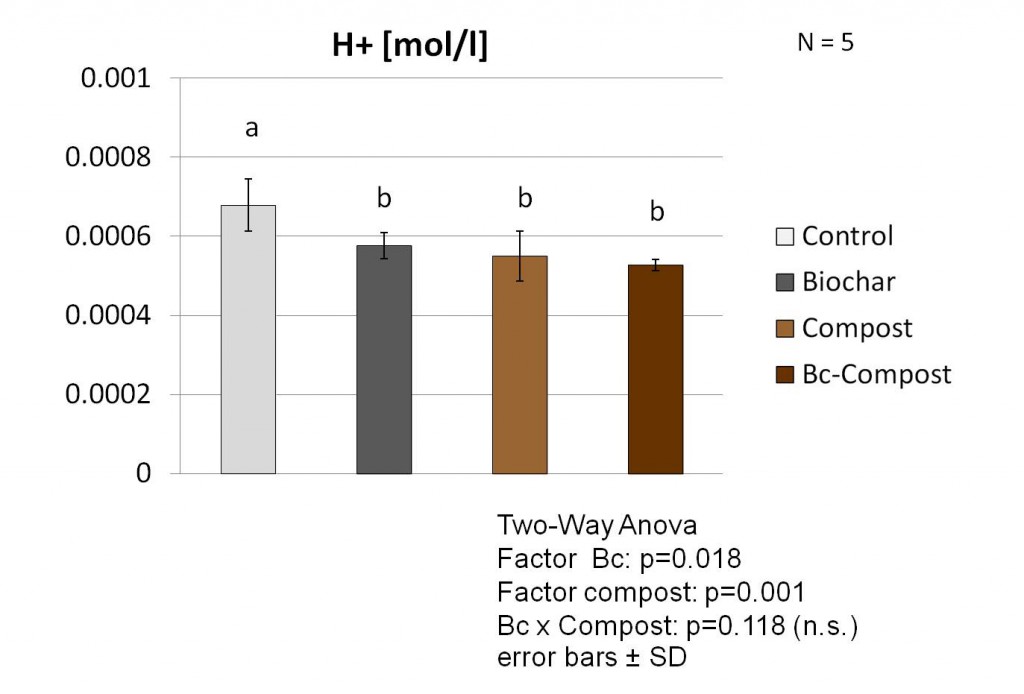
Valais Biochar Experiments 1 (Vagabond): 2011 results

The oldest large-scale field trial using biochar, compost and alfalfa-clover-seed was initiated at the Delinat Institute four years ago and still continues (Valais 1, Experimental Field Vagabonde) (see Experimental Design and Results 2010). Results of the campaign 2011 show positive effects of the biochar plots regarding the growth potential of the vines and their fertility. .No significant effect was observed in the majority of nutrients and grape leaf parameters. Regarding all leaf nutrients, the four treatment plots were within or near the optimal range. In the biochar treatment, the plant uptake of potassium through the grapevine was higher, but magnesium and manganese uptake was lower. In the biochar-compost and compost pure variants, the grapes showed a significant increase in the formation of polyphenols and amino acids compared to the control (Fig. 13).
Valais Experiment 2, Cherouge: 2011 results
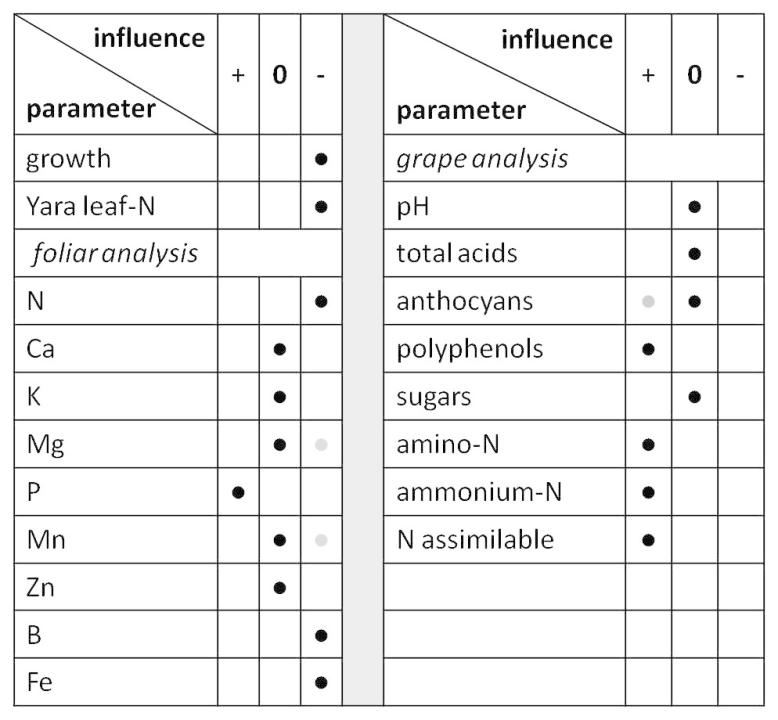
A further experiment with biochar was set up in autumn 2010 in a very steep and exposed terraced vineyard (Valais 2, Experimental Field Cherouge). Pure compost (50 t / ha dry weight) was applied to the control and biochar-compost (22 t / ha + 50 t / ha) was applied to the biochar treatment. The biochar mixture was allowed to rest for 10 days before application. The application was done manually.
The growth potential and leaf nitrogen index were lower at the biochar treatment (Fig. 14). Also, the relative contents of nitrogen, magnesium, manganese, boron and iron in the vine leaves were lower. The polyphenol contents and assimilable nitrogen were higher in the biochar treatment (> 10%).
Summary of all experiments
The summary of the leaf analysis performed in all six experiments with organically activated biochar (3 in Europe, 3 in Valais) provides a wide spectrum with different patterns of reactions. The major nutritional elements, phosphorus and potassium, show a clear positive trend in the nutrient uptake by the vine (Fig. 15). The calcium supply, probably by absorption, is slightly affected in the majority of cases. There seem to be factors that interact with biochar which may be particularly important for the mobility of magnesium and nitrogen.

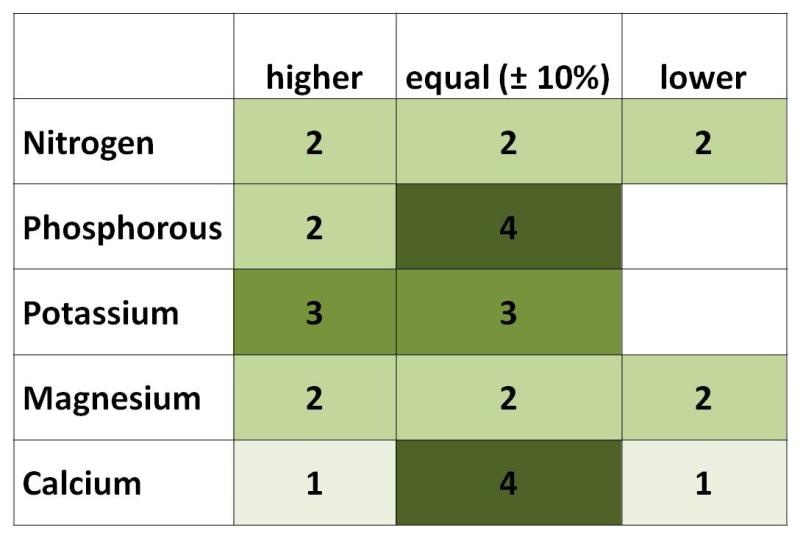
Fig.15. Meta-analysis of grapes (red color) and macronutrients in leaves (green color) based on different biochar experiments in Europe (data for leaves are based on: 6 experiments, 3 sites; data for grapes are based on: 4 experiments, 2 sites).
Discussion
The interactions of biochar with the vine system are very much dependent on factors such as soil properties, tillage, climate, growth and soil microbial activity. Hence, it cannot be expected to find generalized effects for all locations, in particular within the thus far limited time of one vegetation period. One to three vegetation periods is ecologically a short time span for conclusively detecting the effects of biochar. Moreover, it is difficult to judge whether the stronger interactions are due to direct effects between grapevines and biochar, or to indirect effects on plant vegetation or soil microorganisms. Since biological processes are delayed in the dry-climate vineyards it is reasonable that a slower integration into the soil structure may have occurred here. Generally, only a small fraction of biochar may reach the vine rooting zone during a period of only one vegetation season without a profound tillage, although rainy winter seasons will speed up the vertical transport down to greater depths (Major et al. 2010). Therefore, biochar effects that are already evident during the first season will mainly be due to physical and nutrient dynamics in the topsoil.
Increasing water storage capacity probably plays the more crucial role in alkaline vineyard soils, as it can positively influence the biological activity of the topsoil and, in turn, nutrient dynamics.
As evaluated in some cases, positive statements can already be enumerated regarding the impact of biochar: for example, an increase in the yeast-assimilable nitrogen and anthocyanine contents in the grapes as well as in the inflorescences (Wallis 1-3). Findings which may be assessed as negative are reduced growth and decrease in leaf nitrogen below the suboptimal range which were found only in one experiment (Wallis 2).
Some trends are insignificant in the context of achieving optimal values for wine-growing, but provide interesting questions for the basic mechanisms underlying the effects of biochar. An example of an agronomically irrelevant observation is a decreased assimilation of zinc, since this element has a very wide optimum range (see Wallis 3).
In the most recent experiment at the Delinat Institute, the important role of organic matter accompanying the use of biochar was clearly demonstrated.
While the treatment plots with biochar-compost always provided positive tendencies and sometimes insignificant results, the use of pure, non-activated biochar resulted in decreased nutrient availability. The role of activation of biochar with compost or with nitrogen for plant growth has also been confirmed in other studies [Chan 2008, Glaser 2011].
The increase in vine growth in the biochar-compost treatment within just four months demonstrates the potential of substrates, in which the biochar has been integrated right in the beginning of the composting process. Therefore an effective co-application of nutrients is of crucial importance. Otherwise fresh biochar may adsorb dissolved minerals from the soil, inhibiting their uptake by plant roots. Moreover, organic substances formed during pyrolysis and attached to the biochar may microbially be decomposed, causing a condition that withdraws nitrogen and other elements from the surrounding soil matrix (microbial N immobilization which is well known from the application of several fresh organic residues). This can negatively impact cultivated crops particularly in lean, dry soils.
Even if biochar is applied simultaneously with organic fertilizer, the spatial separation of the two substrates after incorporation can still cause local nutrient deficiencies in the soil. One obvious explanation is the slower mineralization of organic fertilizers and subsequent nutrient supply caused by biochar adsorption of organic components and/or microbial and enzymatic inhibition.
We assume that more nutrients are fixed than released if fresh biochar is not saturated with nutrients at the time of application.
In the case of the experiment Wallis 2 (Cherouge) wherein 22 t/ha of biochar was mixed into the compost only after the composting process, the required activation with nutrients was probably not attained. The initial substrate used for the compost was characterized by high wood fiber contents as it was difficult to obtain green leaves and grass clippings in early spring. This resulted in a lignin-rich, relatively low-nitrogen compost substrate. Thus, the biochar was probably not charged sufficiently with nitrogen, which would explain the N-deficiency in the biochar plot compared to the control.
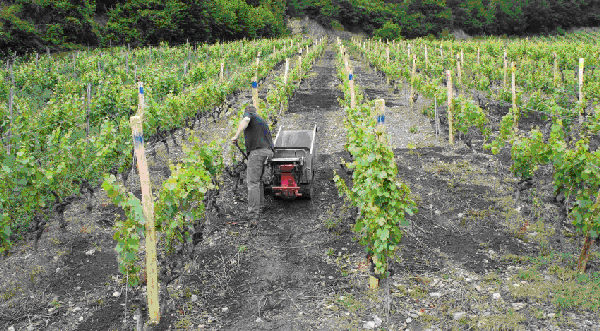
It has to be considered as very positive that biochar brought an increase in anthocyanin content of the red wine grape, Pinot Noir. These phenolic substances are not only responsible for the wine's red color but also act as powerful antioxidants. Despite its relatively poor bioavailability, grape anthocyanin may probably promote people's health [Lila 2004]. The higher content of polyphenols can also have protective functions, increasing the resistance of grapes against fungal attack.
The tendency to increase the yeast-assimilable nitrogen content in the grapes is particularly interesting oenologically, since this parameter is highly important for vinification. A lack of yeast-assimilable nitrogen is an oenological problem, in particular, in very dry locations in southern Europe. Due to climate change, the lack of yeast-assimilable compounds in grapes is now increasingly found in more northern vineyards.
By higher nitrogen levels in the must, the speed and intensity of alcoholic fermentation are increased. This is especially important in natural wine-making, where additives, such as nitrogeneous fermentation aids, are prohibited. It is likely that biochar leads to substantial increase in yeast-assimilable nitrogen due to increases in water availability in the soil.
Should the increase in amino acids and proteins be confirmed also in other crops like grains and vegetables, this will be a significant qualifying factor arguing for the use of biochar in soils to increase its economic advantage.
Conclusion
As found in other field and pot experiments in the last two years, the success of the use of biochar as soil conditioner is dependent on a variety of factors such as soil, climate, biochar quality, manner of activation, crop type, etc. Accordingly, the differences in the experimental plots, despite the unifying experimental factors such as biochar, crop type and set-up, still resulted to a high variance. Careful evaluation of the results over a longer period and the extension of field trials will provide important clues for the rational application of biochar in various agronomic contexts.
The first important result of the investigations presented here is the clear confirmation that the use of pure, non-nutrient activated biochar in the first year can significantly reduce growth due to nutrient blockages.
The charging of biochar through its addition to selected biomass for composting increased the C- and N-efficiency of composting (Publication of Data: Spring 2012). The resulting biochar substrates differed in the first year only slightly from the control composts which were composted without biochar addition. However, the differences almost always showed a tendency for an improved effect for the biochar-compost over the pure compost.
The efficiency of biochar in the soil matrix can only be properly assessed over a longer period. Aside from increasing water storage capacity, the adsorption capacity of biochar has to be taken into consideration. If biochar develops a strong fixation pool for soil organic molecules, as can be expected, it will not only slow down the leaching of nutrients but also encourage the development of humus by allowing the formation of clay-biochar-humus complexes with high microbial activity. These soil formation processes may take place, however, on time scales of several years to decades.
In addition to the biochar experiments presented here, another experiment was done in Valais in 2011. Here, a relatively small amount of biochar (300 kg/ha) was charged with amino acids and injected into the root zone. Data on vines and soil parameters will be analyzed in 2012. But it might just turn out that a slower soil build-up with less but more highly charged biochar level is more effective than a single application of a large amount of biochar compost.
Even if it is possible to see overall positive trends in grape quality parameters, no general recommendation or recipe for the use of biochar in viticulture can be made just now. The experimental plots in the various wine regions will be sampled intensively in 2012. Thus it is expected that by the end of 2012 a more comprehensive data set can be presented to come up with more solid recommendations for practical purposes.
Find the print version of this article here
5. Literature
Carbonneau A.: Principe et méthodes de mesure de la surface foliaire. Essai de caractérisation des types de feuilles dans le genre Vitis. Ann. Amél. Plantes 26 (2), 327–343, 1976.
Chan YK, Van Zwieten L, Meszaros I, Downie A, Joseph S Using poultry litter biochars as soil amendments. Aust J Soil Res 46:437–444 (2008)
Fischer D, Glaser B (2012) Synergisms Between Compost and Biochar for Sustainable Soil Amelioration. In: Management of Organic Waste. Sunil, K. & Bharti, A. (Eds.), InTech, Chapter 10, ISBN 978-953-307-925-7, pp. 167-198
Glaser B, Birk J State of the scientific knowledge on properties and genesis of Anthropogenic Dark Earths in Central Amazonia, Geochimica et Cosmochimica Acta, in press (2011)
Lila MA. 2004. Anthocyanins and human health: An in vitro investigative approach.JBiomedBiotechnol5:306–31Major J, Lehmann J Rondon M, Goodale C: Fate of soil-applied black carbon: downward migration, leaching and soil respiration, Global Change Biology (2009), doi: 10.1111/j.1365-2486.2009.02044.x
Smart RE, Bingham GE (1974) Rapid estimates of relative water content. Plant Physiol 53:258–260
Yao FX, Arbestain MC, Virgel S, Blanco F, Arostegui J, Macia-Agullo, JA, Macias F: Simulated geochemical weathering of a mineral ash-rich biochar in a modified soxhlet reactor. 2010. Chemosphere, 80: 724-732.


Tony Katz
2012-01-28 20:30
Vielen Dank für die Bemühungen und Untersuchungen. Ich hoffe, daß andere landwirschaftliche Nutzungen auch untersucht werden. Speziell: nicht nur die tiefwurzelnden Weinreben, sondern auch "normale" Gemüsearten. Und ganz besonders interessant finde ich: der Einfluß von Pflanzenkohle auf Konvertierungsflächen, also auf ehemals konventionell bewirtschaftete Flächen, die mithilfe der Pflanzenkohle schneller ein ökologisches Biotop bilden können. (ich habe selbst 1,7 ha Acker/Wiesenfläche im MKK Kreis gekauft und möchte es dort gerne mit Pflanzenkohle testen.)
wengertpaule
2012-01-29 16:41
Interessant wäre zu erfahren, wie der Einfluss von Terra Preta auf die Rebgesundheit ausfällt. Wenn es langfristig möglich wäre, Rebschutz einzusparen bzw. überflüssig zu machen, könnte dies doch den Durchbruch dieser Technologie bedeuten.
Pflanzenkohle könnte ja auch durch die sehr große Wasserspeicherfähigkeit interessant in Überschwemmungsgebieten sein. Teure Investitionen im Bereich des Überschwemmungsschutzes könnten deutlich reduziert werden.
Nur ist schade, daß die Verfügbarkeit von Pflanzemkohle noch eingeschränkt ist.
Es wird sich aber hoffentlich noch viel tun.
Danke für den interessanten Beitrag.
Geisenheimerin
2012-01-30 15:56
Ein sehr interessanter Artikel. Mir fiel spontan Einiges ein:
- Was passiert in vernachlässigten Böden mit Pflanzenkohle? "Entladen" sie sich völlig und erschweren dann eine wieder durchzuführende Düngung?
- Ist langfristig gesehen das Ausbringen von Pflanzenkohle auf großen Flächen ökologisch sinnvoll? Viele Wildpflanzen brauchen Magerstandorte. Wird da die Artenvielfalt der Begrünung mit seltenen einheimischen Pflanzen untergraben?
- Eine Bindung von "Schadstoffen" auf belasteten Standorten führt zu einer Fixierung aber nicht zu einer Entfernung dieser Stoffe. Akkumulierung mit den Jahren? Gefahr einer späteren Freisetzung?
Ein wirklich spannender Forschungsbereich. Macht weiter so.
Viele Grüße
hps
2012-02-15 12:20
- Was passiert in vernachlässigten Böden mit Pflanzenkohle? “Entladen” sie sich völlig und erschweren dann eine wieder durchzuführende Düngung?
Durch die im Regenwasser enthaltenen Nährstoffe und die durch die mikrobielle Nährstoffumsetzung im Boden werden die Pflanzenkohlen immer wieder neu aufgeladen. In und um die Pflanzenkohlen entsteht eine besondere Nährstoffdynamik, regelrechte Nährstoffhotspots, mit beständiger Aufladung, Umwandlung, Entladung, Aufladung. Auf diese Weise werden die Pflanzenkohlen nach und nach in den Ton-Humus-Komplex eingebunden und sorgen dadurch für Humusaufbau.
- Ist langfristig gesehen das Ausbringen von Pflanzenkohle auf großen Flächen ökologisch sinnvoll? Viele Wildpflanzen brauchen Magerstandorte. Wird da die Artenvielfalt der Begrünung mit seltenen einheimischen Pflanzen untergraben?
Auf Magerstandorten, die als solche erhalten werden sollen, wäre der Einsatz von Pflanzenkohlesubstraten nicht angeraten und ja auch verschwendete Müh. Pflanzenkohle sollte da eingesetzt werden, wo die biologische Aktivität und der Humusaufbau geförtdert werden soll.
- Eine Bindung von “Schadstoffen” auf belasteten Standorten führt zu einer Fixierung aber nicht zu einer Entfernung dieser Stoffe. Akkumulierung mit den Jahren? Gefahr einer späteren Freisetzung?
Durch die Bindung von Toxinen wird die Bodenaktivität wieder stabilisiert und dadurch eben auch der Abbau wieder gefördert. Für die Bodensanierung ist dies sinnvoll, aber man sollte natürlich darauf achten, nicht immer mehr Schadstoffe in den Boden einzutragen. Irgendwann wäre der Schwamm dann voll und die Bioaktivität bricht zusammen, wodurch sich dann wieder der Abbau verlangsamt. Das liegt aber nicht an der Kohle, sondern am unverminderten Eintrag neuer Schadstoffe.
Danke für die interessanten Fragen, hps
Nicole
2012-01-31 14:51
Interessante Ansätze und insbesondere vielen Dank für die Bemühungen und der Zusammenfassung für uns!
Thumbs up!
Peter Stucki
2012-02-14 19:13
Lieber Hans-Peter
Eure Versuche sind sehr Aufschlussreich, auch die Pionierarbeit welche ihr leistet.
Die Fragen von Geissenheimerin hat mich jedoch schon zum Nachdenken gebracht. Ist eine totale Nährstoffversorgung bei Reben überhaupt sinnvoll, oder wachsen Qualitativ hochstehende Weine nicht auf sehr mageren Böden (Spanien, Bordeaux etc.) und mageren Reben?
Auf alle Fälle glaube ich, dass Kohle hilft ein Gleichgewicht in der Nährstoffversorgung herzustellen.
Grüsse
Peter
Jessica
2012-09-27 13:12
Da dachte ich gut im Thema zu sein und erfahre hier so viel Neues. So gute ansätze und Ideen. Zumeist stehen der Umsetzung guter Ideen, Gesetze und Ämter entgegen. Ob es bei den neuen Ansätzen zur Umsetzung kommen kann, bleibt sicher abzuwarten.
Aber darüber hinaus - Mein Kompliment!
edward schulten
2015-08-13 07:50
Where can I find the 2012-2013 update of this experiment??
Thanks
Cheers!
hps
2015-08-15 10:23
You can find our publication in AEE: https://www.researchgate.net/publication/261919921_Biochar_and_biochar-compost_as_soil_amendments_to_a_vineyard_soil_Influences_on_plant_growth_nutrient_uptake_plant_health_and_grape_quality
kind regards, hp
Holger Wigandt
2016-02-11 08:53
Lieber Hans-Peter Schmidt,
auf Grund Ihrer Forschung und Ihres Artikels habe ich mich mit Kompostierung und Pflanzenkohle näher beschäftigt.
Nun ist mir ein Produkt unter die Hände gekommen dass sich ESK-Protect nennt und laut Vertreiber reiner Kohlstoff ist.
Hersteller Angaben:
ESK Protect wird hergestellt von selektiertem Eichenholz. Die Pyrolyse geht weiter als diese von die Holzkohle für den BBQ. Das Holz ist komplett pyrolysiert und ist nur noch Kohlstoff (> 85% auf TS) und eigentlich ein inertes Material mit eine sehr stark entwickelte Porenstruktur. Die spezifische Oberfläche ist +/- 115m²/Gramm.
Laut des Vertreibers braucht es allerdings keine Aktivierung.
Angaben des Vertreibers:
ESK-Protect wird nicht nur im Weinbau eingesetzt. Auch in Gemüsebau (zB Salat) wird es gebraucht um das Wachstum der Sämlinge zu unterstützen. (Pilze wie Phytium, Rhizoctonia, Fusarium werden neutralisiert). In Salatversuche in Frankreich stellt man auch eine bessere Entwicklung der Wurzel fest. Der Hersteller empfehlt um die Düngermenge zu reduzieren.
Dies wiederspricht Ihren Forschungen oder ist diese "Holzkohle" mit Ihrer "Planzenkohle" nicht zu vergleichen?
Das Produkt wird in unserem Weinanbaugebiet empfohlen.
Was denken Sie darüber?
Mit lieben Grüßen
Holger Wiegandt
hps
2016-02-12 00:28
Lieber Herr Wiegandt, die Werbung der erwähnten Firma ist zumindest unseriös. Wie soll eine Pyrolyse weitergehen als die von Holzkohle, und eine stark entwickelte Porenstruktur bei lediglich 115m2/g ist arg übertrieben. Grundsätzlich sollte Sie ihre Produzenten darauf aufmerksam machen, dass in Europa der EBC-Standard (www.european-biochar.org) gilt, und Anbieter sicher doch, sofern sie nichts zu befürchten haben, zertifizieren lassen sollten. Als Kunde jedenfalls sollte Sie nicht das Risiko des Einsatzes kontaminierter, nicht nachhaltig hergestellter Pflanzenkohle eingehen.
Mit freundlichen Grüssen, Hans-Peter Schmidt